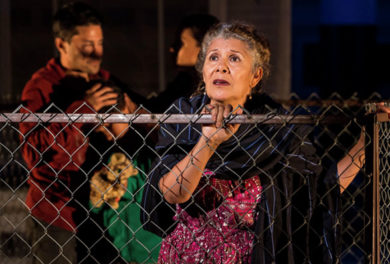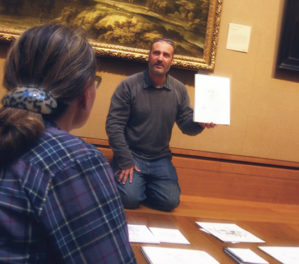
Clockwise from top left, details from: Abraham and Hagar Having Sexual Relations, about 1400–1410. Ms. 33 (88.MP.70), fol. 29. Initial Q: Two Soldiers Leading Two Moors before a King, about 1290–1310. Ms. Ludwig XIV 6 (83.MQ.165), fol. 244. Initial Q: Christ before Pilate, mid-1200s, Ms. 14 (85.MK.239), fol. 63v. Saint Martin Dividing His Cloak, 1469. Ms. 37 (89.ML.35), fol. 34v. Images courtesy of the Getty’s Open Content Program
In the words of sixteenth-century English philosopher Thomas Hobbes, life during the later Middle Ages was “nasty, brutish, and short.” According to Getty Museum curators Kristen Collins and Bryan C. Keene, this view of the past was especially true if you were not a fully abled, white, wealthy, Christian, heterosexual, cisgender male.
The two have published and taught courses on race, ethnicity, and the global Middle Ages. Working with a collection of primarily Western European illuminated manuscripts, they seek to open up traditional narratives about the Middle Ages to reveal a diverse, multicultural, and often intolerant world. Collins and Keene are currently developing an exhibition of manuscripts that sets aside the popular, idealized view of the Middle Ages and takes an intersectional approach to religious prejudice, examining the twinning of antisemitism and Islamophobia and biases against the disabled, the poor, and those who did not fit within the heteronormative standards that governed medieval society.
The curators describe the exhibition as follows:
Medieval manuscripts preserve stories of faith, romance, history, and knowledge, but their texts and luxurious illuminations can reveal more sinister narratives as well. Often created for the privileged classes, such books nevertheless provide glimpses of the marginalized and powerless peoples and highlight their tenuous places in society. Attitudes toward women and gender non-conforming individuals, Jews and Muslims, the poor, and the foreign peoples beyond European borders can be discerned through caricature and polemical imagery, as well as by erasure and censorship.
The exhibition will run from January 30 to April 7, 2018.
Here are a few recommended resources and readings for further background on this topic from an academic and museum perspective:
From the curators
Kristen Collins, “Resonance and Reuse: The Reinvention of a Late-Romanesque Vita Christi in Fifteenth-Century East Anglia”, British Art Studies, issues 6, 2017.
Kristen Collins, “Madness and Innocence: Reading the Infancy Cycle of a Romanesque Vita Christi,” in St. Albans and the Markyate Psalter: Seeing and Reading in Twelfth-Century England, eds. Kristen Collins and Matthew Fisher (Kalamazoo: Medieval Institute Publications, 2018), 307-347.
Kristen Collins and Bryan C. Keene, “Outcasts and Prejudice in the Middle Ages,” Getty Tumblr, 31 March 2017.
Bryan C. Keene, ed. The World in a Book: Manuscripts and the Global Middle Ages, Los Angeles, Getty Publications, in progress.
Bryan C. Keene, “Il medioevo globale: visioni del mondo al Getty Museum,” in Alumina Pagina Miniate (anno 14 n. 52, 2016): 46–51.
Bryan C. Keene and Rheagan Martin, “Coming Out: Queer Erasure and Censorship from the Middle Ages to Modernity,” Getty Iris. 11 October 2016.
Bryan C. Keene, “Global Pathways through Medieval Manuscripts and the Modern Museum,” Getty Iris. 21 January 2016.
From the museum community
The Magi: Legend, Art, and Cult, Schnütgen Museum. 25 October 2014–25 January 2015.
Revealing the African Presence in Renaissance Europe, The Walters Art Museum. 14 October 2012–21 January 2013.
Byzantium and Islam: Age of Transition, 7th–9th Century, The Metropolitan Museum of Art. 14 March–8 July 2012.
Three Faiths: Judaism, Christianity, Islam, The New York Public Library. 22 October 2010–27 February 2011.
Uneasy Communion: Jews, Christians, and the Altarpieces of Medieval Spain, Museum of Biblical Art. 19 February–30 May 2010.
Venice and the Islamic World, 828–1797, The Metropolitan Museum of Art. 27 March–8 July 2007.
See all posts in this series »





I can’t even read about illuminated manuscripts without the so-called elitists cramming nonsense down my throat.
Hi Charles. We’d be interested to hear more of your thoughts on this topic, and wanted to share a more detailed post that I wrote, together with my co-curator Kristen Collins, which hopefully clarifies some of the content we’re hoping to communicate: http://blogs.getty.edu/iris/dialogue-exposing-the-rhetoric-of-exclusion-through-medieval-manuscripts/